flute
All scores that include a part for at least one flute.
-
Haydn - Trio, Hob. XV:18 - arr. Woodwind Quartet
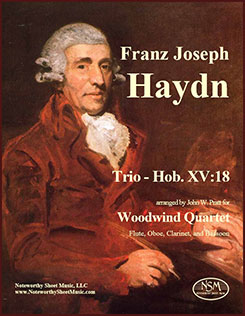 Trio, Hob. XV:18, by Franz Joseph Haydn
Trio, Hob. XV:18, by Franz Joseph Haydntransposed to B-flat major and arranged for Woodwind Quartet by John W. Pratt
Score and Parts for Flute, Oboe, B-flat Clarinet, and Bassoon; PDF $20.97
As noted in the arranger’s forward to the edition, the later piano trios of Franz Joseph Haydn (1732-1809) are superb music, but because they were written for excellent pianists and weak string players, they are dominated by the piano part. This imbalance among the parts actually makes the trios highly amenable to and effective in arrangement for woodwind quartet. Written after Haydn’s first visit to London, the Piano Trio in A major, Hob. XV:18, was first published in 1794. The first of its three movements, a flowing Allegro moderato, is unified by ingenious use of the three-note motif opening its cantabile main theme. The lovely middle Andante, in ABA form and 6/8 meter, features some luxurious ornamentation and proceeds attacca to the spirited and humorous Allegro finale. The resources of a woodwind quartet are well suited to the musical ideas of this trio, and the arrangement adapts Haydn’s piano, violin, and cello lines wonderfully to the range and sonority of the instruments used: flute, oboe, B-flat clarinet, and bassoon. This adaptation is facilitated by transposition from Haydn’s original key of A major to B-flat major. We provide parts plus a score in concert pitch.
Click to listen to computer-generated audio samples from the score; audio clips from movements I (m44.4 - m64.3), II (m0 - m4.5 & m49.6 - m54.5), and III (m36.2.2 - m48) are separated by brief pauses.
Score in concert pitch, 21 pages; Flute part, 8 pages; Oboe part, 6 pages; B♭-Clarinet part, 5 pages; Bassoon part, 5 pages; Total, 52 pages.
Preview -
Haydn - Trio, Hob. XV:25 ‘Gypsy’ - arr. Woodwind Quartet
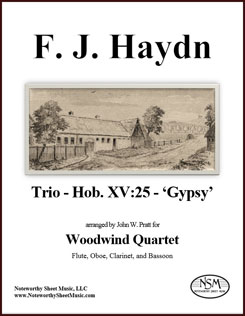 Trio, Hob. XV:25 ‘Gypsy’, by Franz Joseph Haydn
Trio, Hob. XV:25 ‘Gypsy’, by Franz Joseph Haydnarranged for Woodwind Quartet by John W. Pratt
Score and Parts for Flute, Oboe, B♭-Clarinet, and Bassoon; plus, an alternative A-Clarinet part; PDF $16.97
Short summary adapted by NSM from John W. Pratt’s foreword to the edition:The trios Hob. XV: 24-26 were, in Robbins Landon’s account (Haydn, Indiana, 1976), probably the last works Haydn delivered to his publishers before he left England in 1795. They were written for strong amateur pianists and weak string players, and although the string parts are essential for their effects on sonority, they are not terribly interesting. Such a scenario lends itself beautifully to arrangement of these piano trios for wind quartet.
Haydn labeled the finale of Hob. XV: 25 "in the Gypsies' style", and the trio became an enormous favorite. In the key of G, it opens with a particularly lovely slow movement having alternating minor and major variations. The third variation is in the relative minor (e), anticipating the key, E major, of the even slower, but subtle and melodically rich, second movement. This retardation heightens the effect of the famous finale.
We have provided alternative parts for clarinet in B-flat and in clarinet in A. Some players may wish to use the A-clarinet only in the second movement, for the sake of the friendlier key signature and perhaps also for sound, depending on the instrument.
Click to listen to computer-generated audio samples from the score; audio clips from movements I (m42-48, m72-78), II (m57-63), and III (168-190) are separated by brief pauses.
Score in concert pitch, 17 pages; Flute part, 6 pages; Oboe part, 4 pages; B♭-Clarinet part, 6 pages; Bassoon part, 4 pages; alternative part for A-Clarinet, 6 pages; Total, 56 pages.
Preview -
Haydn – Adagio from Symphony No.24 – trans. Solo Flute and Flute Choir
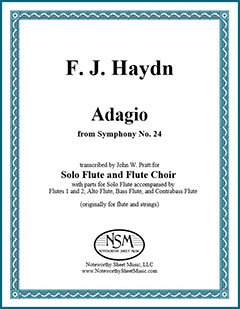 Adagio from Symphony No.24 by F. J. Haydn
Adagio from Symphony No.24 by F. J. HaydnTranscribed for Solo Flute accompanied by Flute Choir, by John W. Pratt (originally for flute and strings)
Score and Parts for Solo Flute, Flutes 1 and 2, Alto Flute, and Bass Flute/Contrabass Flute, PDF $7.99
Haydn wrote his Symphony No.24 in 1764. Its second movement is a beautiful Adagio for flute solo accompanied by strings. The string parts are simple, with no double stops or extreme high notes, so they can be played comfortably by corresponding members of the flute family, except for a few low notes. This transcription for flute choir is therefore straightforward except that the alto flute sometimes plays violin notes that C-flutes cannot play or can use support playing, and similarly the bass flute plays some viola notes instead of or in addition to the alto flute playing them. Notes taken from the cello in its lowest octave have been raised an octave for bass flute, but there are fewer than one might expect. Perhaps one reason is that Haydn expected a (string) bass to be doubling the cello an octave lower, playing from the same part. If a contrabass flute is available, it can double the bass flute similarly, serving even more to enrich the sound. —adapted from JWP’s preface to the edition
Listen to a computer-generated audio sample.
Score, 5 pages; Parts for Solo Flute, 2 pages; Flutes 1 and 2, 2 pages; Alto Flute, 1 page; Bass Flute/Contrabass Flute, 1 page; Total 19 pages.
Preview -
Haydn – Hob. II:21 – arr. Flute Quartet
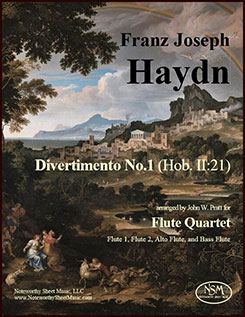 Divertimento No. 1 (Hob. II:21; Op. 2 No. 3) by Franz Joseph Haydn
Divertimento No. 1 (Hob. II:21; Op. 2 No. 3) by Franz Joseph HaydnArranged for Flute Quartet by John W. Pratt (originally for string quartet plus 2 horns)
Score and Parts for Flute 1, Flute 2, Alto Flute, and Bass Flute, PDF $11.97
excerpted from John W. Pratt’s © preface to the edition:
“Haydn (1732-1809) is credited with developing the classical forms of both the string quartet and the symphony, starting from the loose structures and permissive instrumentation of Baroque instrumental music. … His first string quartets are his Opus 1 Nos. 1-4 and 6, and Opus 2 Nos. 1-6, thus eleven. Opus 1 No. 5 is somewhat later, added to make a set of 6, apparently a perfect number in music publication as well as in mathematics. Opus 2 Nos. 3 and 5 are quartet arrangements of two divertimentos including also two horns and listed in the Hoboken catalogue as II:21 and 22 … The spirit and spiritedness of the two divertimentos suit them to flute quartet, as does the distribution of activity. In addition, a flute quartet combines the unified timbre of a string quartet with the wind sound of the horns, while the early string quartets do not exploit the string sound per se. Transposition up a step puts the cello and viola parts of Hob. II:21 mostly within the bass and alto flute ranges and makes the violin parts if anything more comfortable for C flutes.”
There are 5 movements in total: I-Allegro molto, II-Minuet, III-Adagio, IV-Minuet, and V-Finale Allegro. To get some sense of how the Op. 2 No. 3 quartet works with flutes in lieu of strings, listen to this computer-generated audio clip of the first movement—realizing it will of course sound considerably better played in-person on real instruments, post-pandemic.
Score, 11 pages; Flute 1 part, 6 pages; Flute 2 part, 6 pages; Alto Flute part, 5 pages; Bass Flute part, 5 pages; Total, 38 pages.
Preview -
Haydn – Hob. II:22 – arr. Flute Quartet
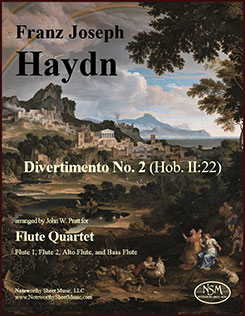 Divertimento No. 2 (Hob. II:22; Op.2, No.5) by Franz Joseph Haydn
Divertimento No. 2 (Hob. II:22; Op.2, No.5) by Franz Joseph HaydnArranged for Flute Quartet by John W. Pratt (originally for string quartet plus 2 horns)
Score and Parts for Flute 1, Flute 2, Alto Flute, and Bass Flute, PDF $10.97
This is the second of Haydn’s two divertimenti, Hob. II:21 and II:22, that John Pratt has arranged for flute quartet, scored for two C-flutes, alto flute, and bass flute. Both divertimenti were written originally for string quartet plus two horns, but were later adapted by others as quartet-only versions identified as Opus 2, No.3 and No.5. Please see the text excerpted from Mr. Pratt’s preface to his arrangement of Haydn’s Divertimento No.1 (Op.2, No.3) for additional information that applies to both these works. There are 5 movements in Op.2, No.5: I-Presto, II-Minuet, III-Largo, IV-Minuet, and V-Finale Presto. Listen to this computer-generated audio clip from the second movement Minuet to get a sense of how the quartet sounds with flutes in lieu of strings.
Score, 10 pages; Flute 1 part, 4 pages; Flute 2 part, 4 pages; Alto Flute part, 4 pages; Bass Flute part, 3 pages; Total, 28 pages.
Preview -
Haydn – Symphony 13 - arr. for Multiple Flutes
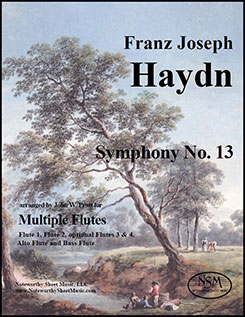 Symphony 13, by Franz Joseph Haydn
Symphony 13, by Franz Joseph HaydnArranged for Multiple Flutes by John W. Pratt
Score and Parts for Flutes 1-4, Alto Flute, Bass Flute; PDF $23.95
This arrangement of Haydn’s Symphony No.13 is for a flute ensemble of any size including at least one bass, one alto, and two concert flutes. Third and fourth concert flute parts are also provided, and all parts can be doubled at will. If a contrabass flute is available, it can double the bass flute, serving to deepen and enrich the sound. The second movement is a beautiful Adagio cantabile, originally for solo cello accompanied by strings, which transcribes nicely for alto flute accompanied by the rest of the flute family. The trio of the symphony’s third movement has a delightful solo flute part with only string accompaniment. A large flute ensemble would be about the size of Haydn’s core orchestra at the time this symphony was composed; in our arrangement, Haydn’s original key has been raised a minor third to better suit the natural range of a flute ensemble.
Score, 17 pages; separate parts for Flute 1, Flute 2, Flute 3, and Flute 4, 6 pages each; Alto Flute part, 7 pages; Bass Flute part, 6 pages; Total, 68 pages.
Preview
-
Herman - Grands Duos Concertantes - Two Flutes
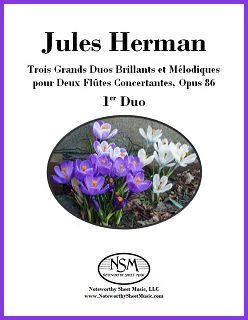 Trois Grands Duos Brillants et Mélodiques pour Deux Flûtes Concertantes, by Jules Herman
Trois Grands Duos Brillants et Mélodiques pour Deux Flûtes Concertantes, by Jules HermanNew Editions by Noteworthy Sheet Music, with a Foreword by P. H. Bloom
Duo 1: Flute 1 Part, Flute 2 Part, and Mini-Score ― PDF $17.98
Duo 2: Flute 1 Part, Flute 2 Part, and Mini-Score ― PDF $21.75
Duo 3: Flute 1 Part, Flute 2 Part, and Mini-Score ― PDF $17.98
Jules Herman's Grands Duos Concertantes (Opus 86) are works of ingenuity, charm, brilliance, grace, and humor. Long overlooked, they are extraordinarily fine examples of concert-worthy duets of the late 19th century. Originally published by Choudens in Paris about 1885, the Grand Duos were dedicated to composer François-Auguste Gevaert (1828–1908), then director of the Royal Conservatory of Brussels. Flutists will find these works challenging and rewarding, teachers of advancing students will be amazed by their utility, and audiences will be enchanted. (excerpted from PHB's © foreword)
Note that these duets make for excellent sight-reading training... the music is interesting and demanding, and the parts are nicely balanced. All three duets have three movements each. Duo 1: Allegro moderato; Adagio sostenuto; and Rondo allegro. Duo 2: Moderato; Scherzando; and Polonaise. Duo 3: Allegretto vivace con brio; Air Varié, Andante; and Boléro, Moderato.
Duo 1: Fl 1 & Fl 2 Mini-Score, 12 pages 2-up; Flute 1 part, 12 pages; Flute 2 part, 12 pages; 40 pages total.Preview Duo 1Duo 2: Fl 1 & Fl 2 Mini-Score, 14 pages 2-up; Flute 1 part, 15 pages; Flute 2 part, 14 pages; 48 pages total.Preview Duo 2Duo 3 Fl 1 & Fl 2 Mini-Score, 11 pages 2-up; Flute 1 part, 12 pages; Flute 2 part, 12 pages; 40 pages total.Preview Duo 3 -
Hewitt - Trip to Nahant - Flute + Clarinet
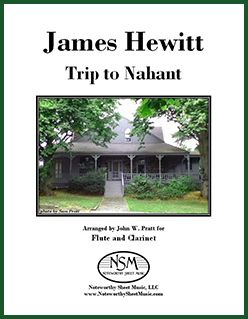 Trip to Nahant, by James Hewitt
Trip to Nahant, by James HewittArranged as a Duet for Flute and Clarinet by John W. Pratt
Flute Part, Bb Clarinet Part, alternate A Clarinet Part, and Score ― PDF $5.99
James Hewitt (1770-1827) moved from London to New York in 1792 and was active in both New York and Boston as a composer, arranger, music publisher, performer, teacher, and orchestra conductor. In Hewitt's time, Nahant was an island connected to the mainland by a sandbar submerged at high tide, now a causeway. It was a popular, cool place for day trips from Boston and later became a fashionable summer resort.
Hewitt's Trip to Nahant, a favorite Rondo (1811) was written for keyboard, and is typical of American music of the period. It is charming, light in texture and subject, and well suited to arrangement for flute and clarinet. (adapted from JWP's foreword to the edition) We provide parts for Flute and Clarinet in Bb, along with an alternative part for Clarinet in A and a Score in concert pitch.
Flute part, 2 pages; Bb Clarinet part, 2 pages; alternate A Clarinet part, 2 pages; Score, 4 pages; Total, 16 pages.
Preview -
Hoffmeister - Sonata in D minor - Flute and Clarinet
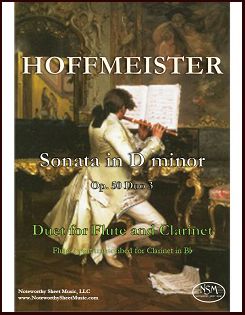 Sonata in D minor, Op.50, Duo 3, by Franz Anton Hoffmeister
Sonata in D minor, Op.50, Duo 3, by Franz Anton Hoffmeister
Duet transcribed for Flute and Bb Clarinet
Score and Parts, PDF $11.25
Noteworthy Sheet Music published an edition of the Sonata in D minor, Duo 3 from Hoffmeister's Trois Duos pour Deux Flûtes, Op.50, after being contacted by flutist Richard A. Evans. Years ago, Mr. Evans had located several editions of 18th and 19th century flute duets, long since out of print, at the Library of Congress. Finding them quite enjoyable to play, and believing them undeserving of their current obscurity, he and his music colleague Bronnie Stroud took the initiative of re-typesetting and editing the pieces using a modern music notation software program. Aware of the paucity of repertoire available for flute and clarinet duo, and realizing these pieces would work nicely for that instrument pair as well, he also transcribed the second flute parts for Bb clarinet. We at NSM agreed that these works should be made more readily available to present-day musicians and audiences, and we published them after making only minor stylistic and formatting revisions to Mr. Evans' scores and parts; the articulation and dynamic markings are those suggested by Mr. Evans.
Preview
Score, 15 pages; Flute part, 8 pages; Bb Clarinet part 8 pages; Total, 34 pages.
-
Hoffmeister - Sonata in D minor, Op.50, Duo 3 - Two Flutes
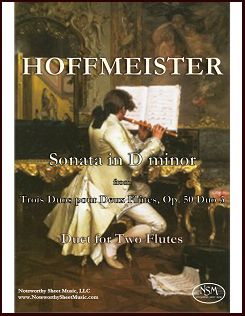 Sonata in D minor, Op.50, Duo 3, by Franz Anton Hoffmeister
Sonata in D minor, Op.50, Duo 3, by Franz Anton HoffmeisterDuet for Two Flutes
Score and Parts, PDF $11.25Franz Anton Hoffmeister (1754-1812) was a German music publisher and prolific composer. He studied law in Vienna, but after becoming captivated by the music scene in that city he devoted the rest of his life to music. His compositional output includes numerous symphonies and overtures, operas, string quartets, pieces for piano, and a great many compositions for flute, including concertos and chamber works. Noteworthy Sheet Music's edition of the Sonata in D minor, Duo 3 from Hoffmeister's Trois Duos pour Deux Flûtes, Op.50 was edited and notated by Richard A. Evans and Bronnie Stroud. Years ago, Mr. Evans located several original editions of 18th and 19th century flute duets, long since out of print, at the Library of Congress. He found them quite enjoyable to play, and undeserving of their current obscurity. NSM agreed and is offering updated editions of these flute-flute duets, as well as editions transcribed for flute and clarinet (browse under under Wind Ensembles or Clarinet).
 Click the mp3 icon to listen to a short audio sample of the Hoffmeister Sonata in D minor first movement, performed and recorded by Demi Stevens, a former student of Richard Evans, playing both parts of the duet.
Click the mp3 icon to listen to a short audio sample of the Hoffmeister Sonata in D minor first movement, performed and recorded by Demi Stevens, a former student of Richard Evans, playing both parts of the duet.
"This is a fabulous duet and has been incredibly fun to practice. Thank you for making it available!"
"Cheers to my mentor's awesome arrangement. I hope you enjoy! With love and admiration, ~Demi"Score, 15 pages; Flute-1 part, 8 pages; Flute-2 part, 8 pages; Total, 34 pages.
Preview
-
Kalliwoda - In die Ferne - Voice, Violin/Flute, & Piano
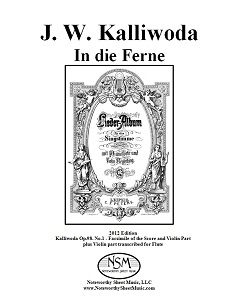 In die Ferne, Op.98, No.1, by J. W. Kalliwoda
In die Ferne, Op.98, No.1, by J. W. KalliwodaFacsimile Edition plus Transcription of Violin part for Flute by C.A.Vater
Score for Violin, Voice, & Piano, Violin Part, Flute Part, PDF $5.99
Johann Wenzel Kalliwoda (1801‒1866) was a Bohemian violinist, conductor, and composer who spent much of his career in Donaueschingen, where he served as the conductor of the court orchestra for Prince Karl Egon II of Fürstenberg. Kalliwoda composed numerous works, including operas, symphonies, pieces for piano, violin and orchestra, and chamber music.
Kalliwoda's song In die Ferne (Far Away) was published in a nineteenth century collection of lieder, along with several songs by Hauptmann and Reinecke. The vocal range of In die Ferne extends from E4 to G#5, and thus is well-suited for either soprano or mezzo-soprano. Our edition contains "enhanced" facsimiles of the original score (violin, voice, and piano) and violin part, plus a transcription of the violin part for flute created using a modern music notation program. Therefore, In die Ferne may be performed using the accompaniment of either violin or flute, along with the voice and piano.
Score, 6 pages; Violin and Flute parts, 1 page each; Total, 12 pages.
Preview
===============
U.S. customers may purchase professionally-printed hard copies of In die Fernefor $10.18 plus a $5.95 shipping and handling fee. Please use the Contact Us form to let us know which print edition(s) you would like to purchase, along with your contact information and your USPO mailing address. -
Lane - Danzas Mecánicas - Wind Quintet
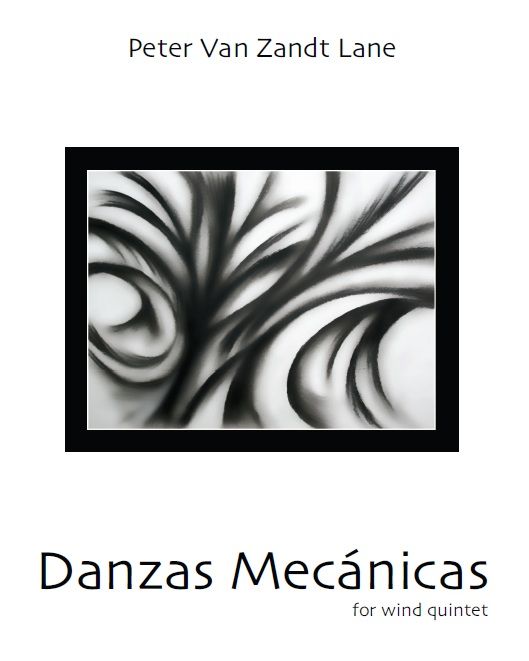 Danzas Mecánicas, by Peter Van Zandt Lane
Danzas Mecánicas, by Peter Van Zandt LaneContemporary Composition for Wind Quintet, PDF $30.00
Peter Van Zandt Lane is a Boston-based composer and bassoonist. His compositions have been performed across the United States, as well as in Europe and South America, by acclaimed musicians and ensembles such as The Cleveland Orchestra, SIGNAL, International Contemporary Ensemble, Dinosaur Annex, New York Virtuoso Singers, Triton Brass, Xanthos Ensemble, East Coast Composers Ensemble, EAR Duo, Quux Collective, and NotaRiotous. He has written for chamber ensemble, wind ensemble, orchestra, and choir, and often employs the use of electronics in his works.
Lane's Danzas Mecánicas - for woodwind quintet (2011) is an exciting 3-movement, 10-minute piece of fairly high difficulty scored for flute, oboe, clarinet, horn, and bassoon. A recording of the piece performed by the Solar Winds Quintet at Slosberg Hall, Brandeis University, in October, 2013 can be heard on YouTube.
Score, 26 pages; Parts, 49 pages; Total, 78 pages.
Preview -
Lane - Seven Rants - Wind Quintet & Piano
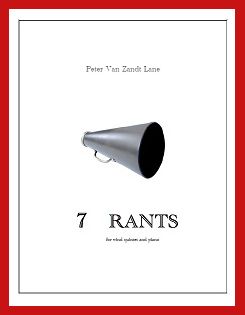 Seven Rants, by Peter Van Zandt Lane
Seven Rants, by Peter Van Zandt LaneContemporary Composition for Flute, Oboe, Clarinet, Horn, Bassoon, and Piano, PDF $0.00
Peter Van Zandt Lane was commissioned to compose this piece for the 67th Composers Conference and Chamber Music Workshop at Wellesley College, which took place in the summer of 2011. The annual Conference is a wonderful two-week event, which brings together prominent young composers, superb professional musicians, dedicated amateur chamber musicians, and enthusiastic listeners. The professional musicians premiere the composers' new works and also coach the amateur musicians in chamber ensembles. Concerts are free and open to the public. For more information on the program, please visit the Composers Conference website.
After the Conference each year, one of the composer fellows is selected to create a new work for the next year's chamber music workshop participants. That composer returns the following summer to coach two groups of players on the new composition, in preparation for performances in the Saturday evening concerts of Week I and Week II. Peter Van Zandt Lane's Seven Rants was an enormous success in 2011, absolutely loved by the players and received exceptionally well by the audience. Written for flute, oboe, clarinet, horn, bassoon, and piano, Seven Rants is a series of seven delightful and diverse movements. The first and last movements are strict palindromes. The five middle movements or "rants" are "mini-concertos", each highlighting a different wind instrument. Great fun to play, and highly accessible.
With permission from both the composer and the Wellesley Composers Conference and Chamber Music Center, Noteworthy Sheet Music is thrilled to offer our customers a free PDF download of Seven Rants by Peter Van Zandt Lane. And please check out more of this terrific young composer's work, including two other listings in the NSM catalog, Danzas Mecánicas and Transverse Fractures.
Score, 37 pages: Flute part, 10 pages; Oboe part, 9 pages; Clarinet part, 10 pages; Horn part, 9 pages; Bassoon part, 9 pages; Piano part, 15 pages; Total, 103 pages.
-
Lane - Transverse Fractures - Flute & Piano
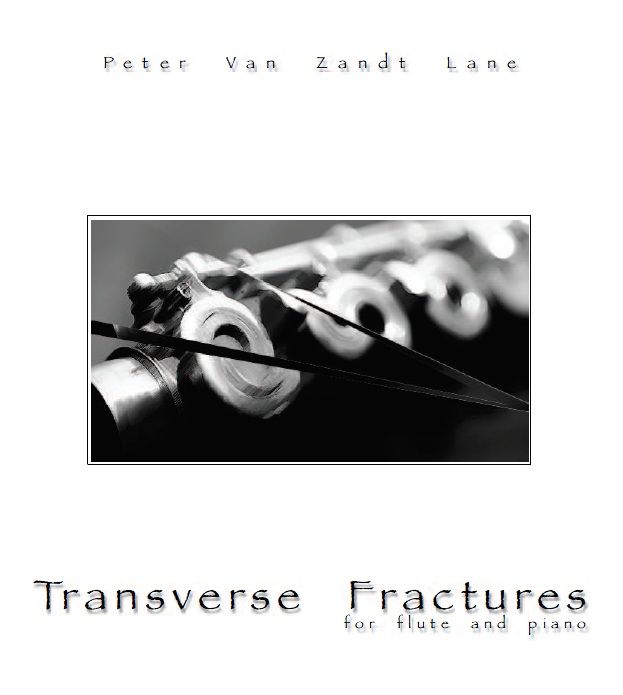 Transverse Fractures, by Peter Van Zandt Lane
Transverse Fractures, by Peter Van Zandt LaneContemporary Composition for Flute and Piano, PDF $20.00
Peter Van Zandt Lane's compositions have been featured on various festivals and conferences such as the New York City Electroacoustic Music Festival, Spark Festival, FEASt Fest, SEAMUS National Conferences, Forecast Music, Festival Miami, and LIPM/IEMS at the world renowned Teatro Colón in Buenos Aires. He has received awards in several competitions including the CRS Young Composers competition, the Forecast Music International Composers Competition, The Greater Miami Youth Symphony Composition Competition, and the Cleveland Orchestra Miami Residency Call for Scores. He has been a finalist twice for the ASCAP/SEAMUS Student Commission, and is an active member of the Composers in Red Sneakers, one of the country's longest-running composer consortiums.
Transverse Fractures (2009) is a short, virtuosic, high-energy duet for flute and piano. The piece was derived from a larger, longer chamber work entitled Partial Fractures, which the composer wrote for NotaRiotous Ensemble. Transverse Fractures, approximately 5 minutes long, is a piece of considerable difficulty for both the flutist and the pianist.
Piano Score, 13 pages; Flute Part, 7 pages; Total, 23 pages.
Preview -
Li Qi - Fog - Flute Alone
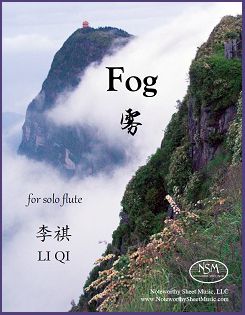 Fog, by Li Qi
Fog, by Li Qi
Contemporary Composition for Solo Flute, PDF $5.99Fog was written in 2012 by the up-and-coming young composer Li Qi. In addition to receiving other projects and awards, Li Qi was selected by the Wellesley Chamber Music Workshop to compose the program's commissioned piece for 2016, An Autumn Dusk in the Mountains for flute1, flute2/alto flute, cello, and piano.
Short, interesting, and challenging, Fog will appeal to advanced flutists and their audiences. Inspired by the poem "Stray Birds" by Rabindranath Tagore, the piece strives to capture in a musical way the recurring interplay between fog and sunlight, as a representation of the circle of life with all its sorrow, joy, and continuously-unfolding beauty. A recording of a 2012 performance of Fog by Heath White at the Jacobs School of Music, Indiana University, has been posted on YouTube; please click the link to listen.Our front cover image is from Wikimedia Commons: "The Mount Emei" by pookieevans (CC BY-SA 2.0).
Preview
Flute part, 3 pages; Total, 7 pages.
-
McDonald - Three Four-Note Flute Duets - Two Flutes
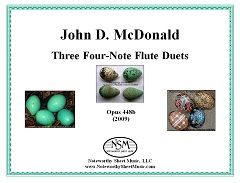 Three Four-Note Flute Duets, Op.448b, by John D. McDonald
Three Four-Note Flute Duets, Op.448b, by John D. McDonaldContemporary Composition for Two Flutes, PDF $2.99
"Composed for Ethel Farny and her flute students at the Rivers Music School, these short duets sprout initially from the first flute/violin duet of Several Strands, Op. 448a. This Grazioso is indeed made from only four pitches. Similarly, Murmurando confines itself to a four-note knot until its final dyad. The third duet, Con Eleganza, stretches the four-note concept a bit more. Each instrument has its own four-pitch pattern, and a coda leaves the four-note idea behind all together, concluding the set with six slower, somewhat more chromatic bars that could very well lead to future music of more emotional complexity. Perhaps there will be more duets to come." ― John McDonald, November 2009
John McDonald is a member of The Mockingbird Trio, directs the Tufts Composers Concert Series, and serves on the boards of several performance organizations in New England. He has recently fulfilled commissions from The Chamber Orchestra of Boston, pianist David Holzman, The Firebird Ensemble (for an Apple Hill Center for Chamber Music Residency, with support from a Meet the Composer MetLife Creative Connections Award), and the ANA Trio (Fredonia University; soprano, cello, and piano), among others. Recent performances by McDonald at the Goethe Institut of Boston, at Tufts, and at many other venues have been highly acclaimed.
Score for Two Flutes, 2 pages; Total, 4 pages.
-
McDonald - Three Melodies That Descend - Flute
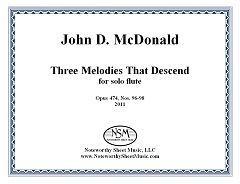 Three Melodies That Descend, Op.474, Nos.96-98 by John D. McDonald
Three Melodies That Descend, Op.474, Nos.96-98 by John D. McDonaldContemporary Composition for Solo Flute, $2.99
John McDonald is Professor of Music at Tufts University, where he served as Director of Graduate Music Studies from 2000 to 2010 and Department Chair from 2000 to 2003. He was named the 2007 MTNA—Shepherd Distinguished Composer of the Year by the Music Teachers National Association, and received the 2009 Lillian and Joseph Leibner Award for Distinguished Teaching and Advising from Tufts University. In 2010, he received the Waring Prize from Western Reserve Academy, the highest award given to alumni of that school. His recordings appear on the Albany, Archetype, Boston, Bridge, Capstone, Neuma, New Ariel, and New World labels, and he has concertized widely as composer, pianist, and collaborative performer. New releases include pianist Andrew Rangell's performance of McDonald's Meditation Before A Sonata: Dew Cloth, Dream Drapery, on Bridge Records.
McDonald's Three Melodies That Descend, Op.474, Nos.96-98 were written for composer and flutist Joshua Hahn after his graduation from Tufts University in May 2011. They work on the principle that what starts high must come down, and they are also a foil to the Eleven Melodies That Go Up In Different Ways (Op. 474, Nos. 30-40).
Flute part, 2 pages; Total, 4 pages.
-
Mendelssohn - Concert Piece No.1 - Two Winds and Piano
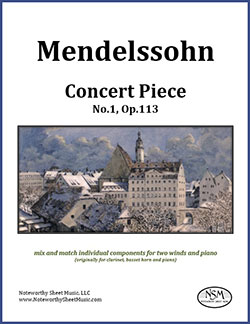 Concert Piece No.1, Op.113, by Felix Mendelssohn
Concert Piece No.1, Op.113, by Felix MendelssohnTranscribed for Various Wind Instruments and Piano by John W. Pratt
(originally for Clarinet, Basset Horn, and Piano)
Individual Primo parts for Clarinet, Flute, or Oboe, PDFs $6.99 each
Individual Secondo parts for Bassoon, Clarinet, or English Horn, PDFs $6.99 each
Piano Score, with original Clarinet and Basset Horn lines in concert pitch, PDF $6.99
The following is excerpted from John Pratt's © foreword:
"In 1833, Felix Mendelssohn (1809-1847) wrote two Concert Pieces for Clarinet, Basset Horn, and Piano, op. 113 and op. 114, as show-pieces for the famous clarinetist Heinrich Bärmann (1784-1847) to play with his up-and-coming son Karl (1811-1885) on the basset horn. // Mendelssohn's two Concert Pieces are very suitable for transcription, even aside from the rarity of the basset horn today. We provide, as well as the original clarinet part, transcriptions of it for flute and oboe. Transcriptions of the basset horn part are provided for bassoon, clarinet, and English horn. These primo and secondo parts can be mixed and matched at will. For the score, we use Mendelssohn's instruments rather than some other arbitrary pair. This enables anyone interested to check any transcribed part against the original. The score gives the parts in concert pitch, because a transposition would apply to only one of the possible winds, and because the pianist can then easily play any part at original pitch."Please note that PDFs of the original score and clarinet-primo part are available free of charge in the public domain (see the listing of this work on IMSLP.org), and our transcribed primo and secondo wind parts can readily be used with the original score. Therefore, you should purchase our original instrument Score or Clarinet-primo part only if you would like measure numbers or Mr. Pratt's score (for piano with clarinet and basset horn) in concert pitch.
- Piano Score with Clarinet and Basset Horn lines in concert pitch, 8 pages; Total, 10 pages (note that the original score is freely available on IMSLP.org)
- Clarinet in B-flat, primo part, 4 pages; Total, 6 pages (note that the original clarinet part is freely available on IMSLP.org)
- Flute, transcribed primo part, 4 pages; Total, 6 pages
- Oboe, transcribed primo part, 4 pages; Total, 6 pages
- Bassoon, transcribed secondo part, 4 pages; Total, 6 pages
- Clarinet in B-flat, transcribed secondo part, 4 pages; Total, 6 pages
- English Horn, transcribed secondo part, 4 pages; Total, 6 pages
-
Mendelssohn - Concert Piece No.2 - Two Winds (and Piano)
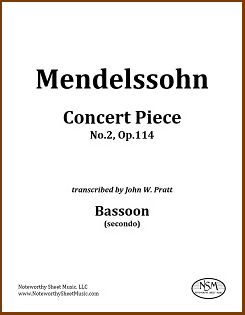 Concert Piece No.2, Op.114, by Felix Mendelssohn
Concert Piece No.2, Op.114, by Felix MendelssohnTranscribed for Various Wind Instruments (and piano) by John W. Pratt
(originally for Clarinet, Basset Horn, and Piano)
Primo parts for Clarinet, Flute, or Oboe, PDFs $5.99 each
Secondo parts for Bassoon, Clarinet, or English Horn, PDFs $5.99 each
The following is excerpted from John Pratt's © foreword:
In 1833, Felix Mendelssohn (1809-1847) wrote two Concert Pieces for Clarinet, Basset Horn, and Piano, op. 113 and op. 114, as show-pieces for the famous clarinetist Heinrich Bärmann (1784-1847) to play with his up-and-coming son Karl (1811-1885) on the basset horn. // These works are very suitable for transcription, even aside from the rarity of the basset horn today. We provide, as well as the original clarinet part, transcriptions of it for flute and oboe. Transcriptions of the basset horn part are provided for bassoon, clarinet, and English horn. These primo and secondo parts can be mixed and matched at will. // Since a good quality PDF of the original piano score with excellent page turns is freely available in the public domain (see IMSLP.org), we have not provided a score here; our transcribed primo and secondo wind parts can readily be used with the original score.
Each wind part is 4 pages of music; 6 pages total.
Primo parts for Flute, Clarinet in B-flat (note that the original primo clarinet part is freely available on IMSLP.org), or Oboe.
Secondo parts for Clarinet in B-flat, Bassoon, or English Horn. Preview Bassoon II part
-
Mozart - Sinfonia Concertante - Fl/Cl/Pf
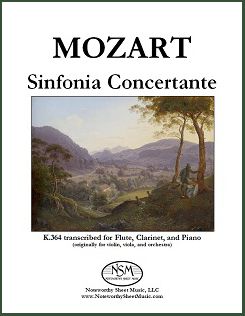 Sinfonia Concertante, K.364, by Wolfgang Amadeus Mozart
Sinfonia Concertante, K.364, by Wolfgang Amadeus MozartTranscribed for Flute, Clarinet, and Piano by John W. Pratt
(originally for Violin, Viola, and Orchestra)
Piano Score, Flute & Clarinet Parts, PDF $17.99
Excerpted from the Foreword by J. W. Pratt: "The idea that every piece, especially a major one, can be satisfactorily transcribed for whatever instruments one would like is one I firmly reject. However, a trio arrangement of this Sinfonia Concertante for flute, clarinet, and piano can, I believe, capture and present in a new light many of the wonders of this great work, even the wonders of its sonorities..... In the arrangement here, the flute and clarinet almost always play either a solo part or an orchestral part with only octave changes..... For the piano, on the other hand, straightforward orchestral reduction is often ineffective and unsatisfying, and that would certainly be true here, even with the flute and clarinet taking some wind parts. I have attempted instead to find natural piano "orchestrations" as alternatives to Mozart's orchestral layouts, especially where the full orchestra is playing..... Such effects, often heightened on returns, are better suited to the piano's capabilities and its role as a member of a trio than a straightforward reduction would be..... The music available for flute, clarinet, and piano includes surprisingly few major works. The purpose of our arrangement is to add a significant piece to this repertoire and to enable players and listeners to enjoy Mozart's magnificent Sinfonia Concertante in a new way."
Score, 41 pages; Flute part, 18 pages; Clarinet part, 17 pages; Total, 82 pages.
Preview